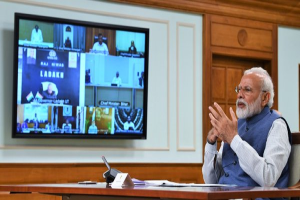COVID-19 in India: Re-emergence of the Centre and Prime Minister Narendra Modi
S Narayan
27 April 2020Summary
The management of the COVID-19 crisis has led to the re-emergence of central authority in India, dilution of federalism and re-establishment of Prime Minister Narendra Modi as a national leader.
The management of the COVID-19 pandemic in India has had two key side-effects – the re-emergence of Prime Minister Narendra Modi as a national leader and the centralisation of decision-making in India. On 24 April 2020, Modi spoke to the village heads (sarpanch) directly from Delhi through video, and earlier in March 2020, to a group of beneficiaries of various welfare programmes. During these interactions, he reached over and above the heads of state governments and institutions to convey the message that the central government cares and is doing all it can to beat the pandemic. Further, in his meetings with Chief Ministers, he is fulsome in his praise of the actions taken by the states, listens to suggestions from them and has accepted several of them, most notably the extension of the lockdown until 3 May 2020. He has also promised to be consultative in the opening up of the restrictions, leaving states to decide on action on hot spots.
In the months after the general elections in May 2019, the Modi government had brought in a series of measures such as the revocation of Article 370 in Kashmir, the Citizenship Amendment Act and the enumeration of a National Register of Citizens, all measures that appeared to further a core Bharatiya Janata Party ideological agenda. These measures received much criticism from citizenry, the states and even from international media. It did appear at that time that Modi had ceded space to hardline ideologues in his party. The COVID-19 crisis has helped consolidate influence and decision-making in the central government and enhanced his role in managing the crisis.
Financial Crisis for the States
The Indian government invoked the Epidemic Diseases Act of 1897, as well as the National Disaster Management Act, 2005, to direct the nation into a 21-day lockdown of all activities. States draw a substantial portion of their revenues from the Goods and Services Tax (GST) as well as duties on petroleum products. The cash cow, however, is excise on liquor sales that generates huge revenue for them.
The directions under the 1897 Act have prevented the sale of liquor in order to avoid public gatherings and the lockdown has effectively ensured that revenues from petroleum products too dropped steeply. This is perhaps the first time that liquor sales have been banned nationally. The excise on liquor is a state subject under the Constitution, and as a result of this move, revenues of the states have decreased significantly. Coupled with the fact that the lockdown has reduced economic and commercial activities to a trickle, the states are struggling to remain financially afloat, and within a couple of months, would find it difficult to even pay salaries.
As a consequence, they would have to turn towards the central government for financial assistance. There is a similar development in the United States, where the Governors have had to agree to a number of Federal directives to gain access to federal funds. The Indian states are accepting central directions and guidelines with alacrity. Even West Bengal, always an outlier, has had to accept central directives and revise its COVID-19 figures of those affected and the mortality rates to more credible levels. Kerala too has agreed to withdraw certain relaxations that the Centre felt should remain. The Prime Minister, being consultative and not combative, has helped, especially since the states are supplicants for funds. Normally a Prime Minister speaking directly to village leaders would have caused a lot of consternation among the states led by opposition parties. However, the protests have been muted. Even the multitude of instructions from the Home Ministry, clearly indicating that better thinking could have brought in more clarity, have not incensed the states.
As in some other countries, the centralisation of authority and, consequently, the dilution of the federal nature of economic decision-making, are now palpable. Added to it is the resurgence of the personal image of the Prime Minister and the reassuring messages that are conveyed by him. It is evident that the post-COVID era will see a greater role of the government, especially in dealing with the poor and disadvantaged. The central government and the Prime Minister are preparing themselves to fulfill this role, leaving the states to be secondary players.
In a vibrant democracy like India, it is unlikely that the opposition parties and, indeed, states ruled by the opposition parties, will allow this balance to last, but that would happen only after the return of some semblance of economic revival.
. . . .
Dr S Narayan is Visiting Senior Research Fellow at the Institute of South Asian Studies (ISAS), an autonomous research institute at the National University of Singapore (NUS). He is a former Chief Economic Advisor to the Prime Minister of India. He can be contacted at snarayan43@gmail.com. The author bears full responsibility for the facts cited and opinions expressed in this paper.
-
 More From :
More From :
-
 Tags :
Tags :
-
 Download PDF
Download PDF



